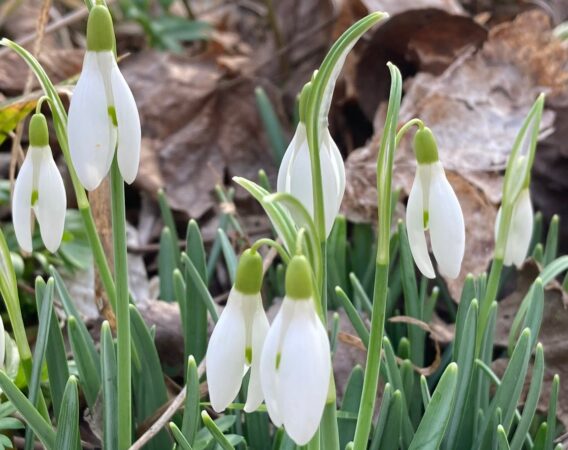It’s about that time of year. The holidays are over, and we are impatient for spring. There may still be snow on the ground. However, the days are beginning to grow longer again, and there are some early signs of spring appearing in February if you look closely. Read on to learn about the remarkable wildflowers that bloom in February.

Skunk Cabbage
Symplocarpus foetidus
The skunk cabbage is one of the first flowers of spring. It appears in early February in woods and wetlands. The skunk cabbage flower may not be a stereotypical flower, but it is definitely a uniquely interesting one. The flower actually heats itself up to about 70 degrees Fahrenheit, which will melt the snow in the surrounding area, giving the plant access to the sunlight above. The “skunk” cabbage flower also has a mottled appearance and gives off a stinky smell that attracts its main pollinator – flies.
Winter Aconite
Eranthis hyemalis
The winter aconite is another flower that can appear in early February. Part of the buttercup family Ranunculaceae, it is a striking yellow color that appears in mats on the forest floor. The plant is native to Europe and Asia but is commonly found in North America as well. All parts of the plant are poisonous.


Snow Drops
Galanthus spp.
Snow drops are the perfect example of a wildflower commonly seen poking through the snow in early spring. They are found native in Europe and Asia and naturalized throughout North America in woods and grasslands.
Daffodils
Narcissus spp.
Daffodils are native to Southern Europe and Northern Africa but have been naturalized throughout the world for hundreds of years. There are about 50 different species of daffodils, most being some form of white or yellow in color. Most species flower in late winter to early spring.


Crocus
Crocus spp.
The crocus genus is in the iris family Iridaceae. Crocus are native to parts of Europe, Asia, and Africa but have been introduced in many other parts of the world as well. The crocus genus is composed of about 100 different species, the most well-known species being Crocus sativus – the saffron crocus. Crocus are one of the earliest blooming spring flowers, commonly seen emerging in the snow.
Violets
Viola spp.
The genus Viola contains over 500 species. The Viola sororia species is native to North America and one of the most common wild violets – referred to as “wild violet”, “wood violet”, or “common blue violet”.
Violets are found in forests, lawns, and gardens. They can be found blooming as early as late winter.

Spring Is Coming!
If you find yourself outside on a sunny day in February, you may just see one of these beautiful wildflowers. Most of them are quite common where they grow and are widely distributed. All of them are a sure sign that spring is finally on the way. What other wildflowers have you seen blooming in early spring? Leave a comment down below and share.
Speaking of February, check out my last blog post about the meaning behind different rose colors on Valentine’s Day as well.

